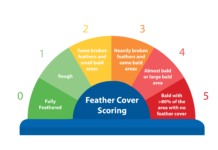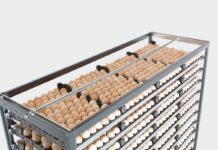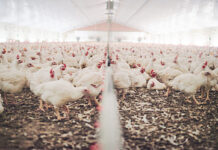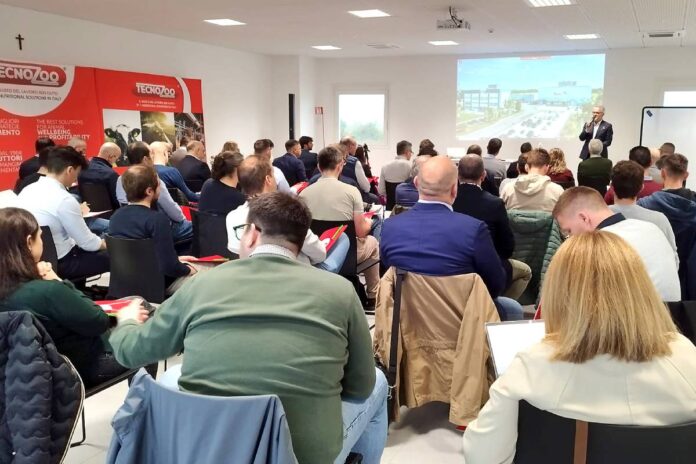
In Piombino Dese, in the province of Padua, farmers, veterinarians, and technicians gathered to discuss the most pressing topics in the poultry sector.
The recent Tecnozoo conference sparked a lively exchange of ideas among poultry sector professionals. Breeders, veterinarians, technicians, and nutritionists convened to discuss recent advancements in critical aspects of poultry farming, such as intestinal health, shell quality, and lighting. The speakers addressed a range of topics with both scientific and practical perspectives, with innovation as the common thread. Their goal was to outline a path toward more sustainable farming practices that enhance the productive longevity of animals.
The day began with an introduction by Dr. Gianluca Favaro, General Manager of Tecnozoo, who highlighted how the company’s DNA is deeply rooted in a passion and dedication to supporting professionals and operators in the sector, guiding them through their evolution and growth. “Today, as we look to the future, our commitment is stronger than ever. We aim to be leaders in poultry farming, embracing forward-thinking approaches, investing boldly in innovation, and prioritizing sustainability.”
Dr. Enrico Tazzioli, nutritionist and head of the poultry sector at Tecnozoo, then took the stage to introduce the topics on the agenda and present the distinguished speakers. These experts will “undoubtedly enrich the conference, providing valuable opportunities for learning, idea exchange, and establishing the groundwork for an innovative and sustainable future in livestock farming.”
Dr. Alessandro Scolari, veterinarian and director of the Vallerana Diagnostic Laboratory, opened the session with a presentation on “Alternative Products for Maintaining Intestinal Health in Poultry Farming. Assessments of their impact on the microbiome.” The discussion quickly turned to the significant reduction in antibiotic use over recent years, highlighting the poultry sector’s commitment to sustainability: by 2021, antibiotic usage had dropped by 90% compared to 2011. The introduction underscored the rationale for adopting alternative substances and products to combat emerging health challenges, including occasional increases in mortality during the initial weeks of life, greater group disuniformity, cases of lameness, and enterococcal spondylitis (affecting up to 1-10% of male poultry). Furthermore, there has been a rise in conditions associated with the growth of gram-positive bacteria, including necrotic enteritis, gangrenous dermatitis, botulism, enterococcosis, and staphylococcosis.
The primary focus in all cases is intestinal health, with the gut acting as the first barrier against potential pathogens. Intestinal polymicrobism, particularly when accompanied by inflamed or damaged mucosa, can result in bacterial translocation into the skeletal system – an issue most apparent in broiler chickens. This condition leads to group disuniformity and health complications, which, in turn, affect performance, shell quality, hatchability, and ultimately, the quality of the chicks produced.
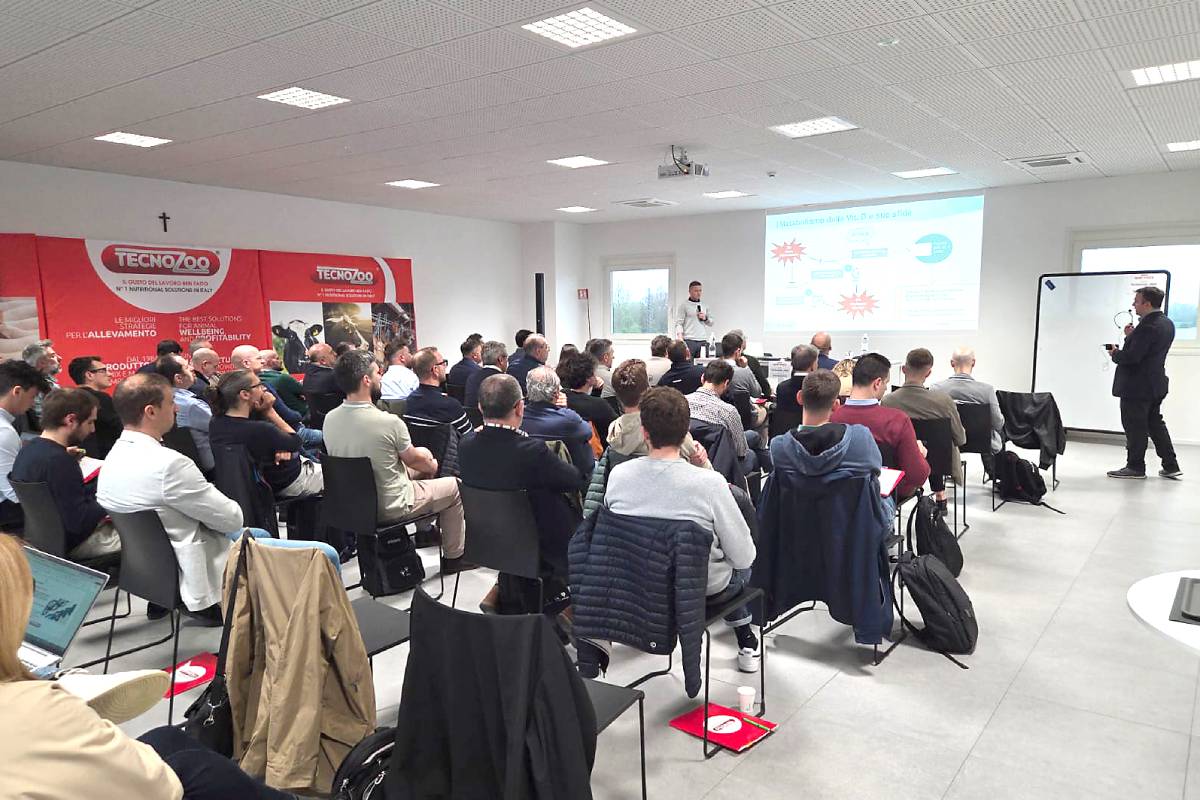 The intestinal microbiota can be seen as an ‘invisible army’ that supports animal health. A balanced microbiome is crucial not only for maintaining intestinal health in the strict sense, but also for the absorption of essential nutrients, ensuring the production of eggs with strong shells and promoting proper growth rates. The speaker explored the various bacterial phyla within the intestinal microbiota, highlighting the numerous interactions between microbial populations and their relationships. These dynamics can be disrupted by negative factors such as stress and disease, or positively influenced by the use of alternative products, phytobiotics, prebiotics, probiotics, postbiotics, and organic acids. Synergistic interactions have been observed between biologically active substances in alternative products, particularly between organic acids and phytobiotics. The antioxidant, antimicrobial, and mucosal protective effects of phytobiotics are enhanced by the selective antimicrobial activity of organic acids.
The intestinal microbiota can be seen as an ‘invisible army’ that supports animal health. A balanced microbiome is crucial not only for maintaining intestinal health in the strict sense, but also for the absorption of essential nutrients, ensuring the production of eggs with strong shells and promoting proper growth rates. The speaker explored the various bacterial phyla within the intestinal microbiota, highlighting the numerous interactions between microbial populations and their relationships. These dynamics can be disrupted by negative factors such as stress and disease, or positively influenced by the use of alternative products, phytobiotics, prebiotics, probiotics, postbiotics, and organic acids. Synergistic interactions have been observed between biologically active substances in alternative products, particularly between organic acids and phytobiotics. The antioxidant, antimicrobial, and mucosal protective effects of phytobiotics are enhanced by the selective antimicrobial activity of organic acids.
Finally, an advanced metagenomic analytical technique was described for the statistical quantification of intestinal bacterial populations. Using 60 stool samples, pooled in sets of 10 per group, the technique was employed to identify both beneficial changes (e.g., increases in Firmicutes and/or Bacteroidetes) and detrimental shifts (e.g., an increase in proteobacteria) in the intestinal microbiota. These changes were attributed to factors such as stressors, environmental conditions, diseases, or interventions with alternative products. This tool is instrumental in further reducing the need for antibiotics by enhancing our understanding of the development and modification of the enteric microbiota, a key factor in maintaining the integrity and health of animals’ intestines.
Dr. Murat Devlikamov from the German Phytobiotics was the second speaker of the day, discussing a key topic in sustainability and the environmental impact of poultry farms: the quality of eggshells and the nutritional strategies essential for their long-term preservation.
The presentation covered several key topics, starting with the role of activated vitamin D3 in calcium metabolism, its contribution to strengthening the immune system, and its antioxidant and antibacterial effects. Active D is a product composed of a blend of selected plants, including golden oats, which contains the active form of vitamin D (calcitriol glycosidate 1,25-OH-D3). It was demonstrated how this compound bypasses the liver and kidneys – the organs responsible for the endogenous metabolism of vitamin D3 – thereby enhancing calcium absorption from the intestine, its release from bones, and its reabsorption in the kidneys, even in the presence of chronic health issues. Through the presentation of several experimental studies conducted on groups of laying hens and breeding eggs, the continuous use of this product throughout the life cycle of breeding birds was recommended, in addition to normal levels of vitamin D3. The studies provided evidence of a direct improvement in eggshell quality and, indirectly, in the quality of the embryos and offspring produced. For commercial laying hens, a more targeted approach has been recommended, particularly during the final stages of their life cycle, starting from the sixtieth week. An interesting point highlighted during the presentation was the advantage of using this product in two additional phases: during weaning, to further strengthen the skeletal system of the animals, and at the onset of the laying cycle, to support the final stages of growth and the formation of medullary bone (16-20 weeks).
Several trace elements play a key role in the normal metabolic pathway of calcium. Special emphasis was placed on zinc, copper, and manganese, all of which are essential for the development of a strong egg structure. These elements enhance calcium deposition, improve shell integrity, and provide protection against oxidative stress, reducing the occurrence of thin shells. The use of the enzyme phytase facilitates the release of phosphate from phytates naturally found in raw materials used for animal feed, contributing to a reduction in phosphate levels in the feed, which is significant from an environmental impact perspective. The discussion concluded with an examination of usable calcium sources. The characteristics of these sources, including particle size and the amount to be incorporated into the feed, are influenced by the age, physiological conditions, and food intake of the animals. The Ca:P ratio, as well as the use of larger calcium particles, increases with the advancing stages of the animal’s life cycle (such as for laying hens and breeders). One of the central themes highlighted in the report was the critical role of intestinal health, especially mucosal integrity, in enabling efficient nutrient absorption.
 The last presentation of the day focused on an innovative technology: dynamic intelligent lighting of poultry farms. In collaboration with Once by Signify_Philips Lighting, Nice Hasani shed light on the topic by first exploring the core concepts of photobiology (the study of light’s interaction with living organisms). describing light sources as a language that helps understand bird behaviour and their interactions with the environment.
The last presentation of the day focused on an innovative technology: dynamic intelligent lighting of poultry farms. In collaboration with Once by Signify_Philips Lighting, Nice Hasani shed light on the topic by first exploring the core concepts of photobiology (the study of light’s interaction with living organisms). describing light sources as a language that helps understand bird behaviour and their interactions with the environment.
There are species-specific differences in visual perception, with birds notably capable of perceiving a wider range of the light spectrum (360–750 nm) than humans. In poultry, the ratio of cones to rods is strongly skewed toward cones, at approximately 85%, indicating that birds perceive light differently from humans. They are sensitive to red, green, and blue pigments even at low intensities (as low as 8 lux), and they can also detect UV-A wavelengths. For this reason, it is essential to measure light intensity using Gallilux, a unit capable of accounting for these unique visual sensitivities. Several dynamic lighting ‘recipes’ were presented, designed to enhance animal performance throughout the production cycle. These lighting programs are adaptable and follow the birds’ natural circadian rhythms, changing throughout the day to support their physiological and behavioural needs. During the chick weaning phase, studies conducted at Wageningen University have shown that, in the early stages, a high colour rendering index spectrum—known as the Jungle Green Spectrum—stimulates movement as well as feeding and drinking behaviours. In the later stages of broiler growth, a blue-green spectrum referred to as ‘Jungle Sky’ has proven effective in enhancing flock uniformity and overall growth performance. Additionally, a monochromatic blue spectrum has been found to have a calming effect on birds during handling procedures such as transfer to laying facilities or vaccinations. Red-spectrum electromagnetic waves have been shown to play a key role in the reproductive development of laying hens by stimulating hormone release for sexual maturation. They also help regulate melatonin levels, thereby enhancing immune function and reducing stress.
“Dynamic multi-spectral lighting offers an effective solution to the challenges encountered in aviary systems. Given the complexity and high activity levels of laying hens, lighting must be both flexible and responsive to their changing behavioural and physiological needs. This system helps mitigate several undesirable behaviours, including feather pecking, cannibalism, off-nest egg laying, smothering, and uneven distribution of birds within the facility. With intelligent lighting management programs like NatureDynamics, both light intensity and spectrum (colour) are dynamically adjusted throughout the day. This supports the farmer by influencing animal behaviour – for example, encouraging egg laying with a warm white light enriched in red wavelengths, or discouraging out-of-nest laying with a cool white or blue spectrum. All of these elements carry important economic repercussions, notably through improved quality of selectable eggs, better animal health and welfare, and a reduction in stress-related and abnormal behaviours.
These developments underscore the significant strides made by scientific research in addressing the increasingly complex demands for productive efficiency, sustainability, and animal welfare. Such innovations play a key role in enhancing the resilience of poultry, supporting longer and more consistent production cycles.
The event concluded with a productive discussion on the key issues addressed, highlighting Tecnozoo’s dedication to working closely with its customers. Through this initiative, the company has showcased its commitment to navigating the future challenges of poultry farming with both passion and expertise.



